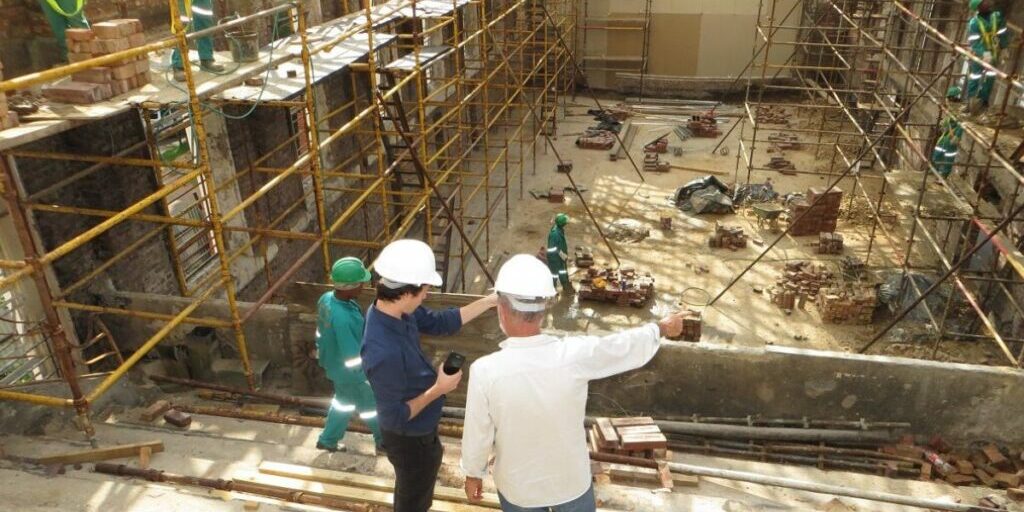9 Benefits to Keeping Owners and Contractors on the Same Construction Software Platform

Getting owners to work on the same construction software platform as contractors has numerous benefits.
Construction sites often consist of multiple teams from separate companies. Each has its internal processes to track its work and project details. Smaller contractors may rely on spreadsheets or written notes. Excel is the staple for construction companies around the world. Other companies may have more robust systems for construction project management that are designed specifically for construction. But each of them may be different from what other contractors on the job are using, and separate accounts don’t always integrate well.
These separate silos of information create bottlenecks in the flow of communication. Somebody needs to transfer critical information from one platform to the next manually. Contractors may lose data in translation, copy it incorrectly, or forget about it. Keeping track of the entire project’s daily records is very time-consuming, and among the reasons, so many projects go over budget and beyond their initially planned schedule. Once you fall behind in your bookkeeping, it isn’t easy to get back on track.
The advent of construction management software platforms such as Linarc greatly helps companies stay on the same page. They can do so by connecting everyone to the owners commissioning the project. Connecting everyone on the job is the ultimate “open door” policy where everyone on the project can have a two-way relationship with the people funding the work. By implementing a company and contractor-wide solution, people are treated as a unified team, regardless of who ultimately gives them their paycheck.
There are many reasons to keep everyone on the same construction management software platform. These range from convenience to compliance and several steps along the way. While we couldn’t list them all, here are nine ways construction companies benefit from uniting owners and contractors on a single all-encompassing software platform.
Keep reading for,
- Real-Time Communication with Management
- Company-wide Visibility on the same Construction Software Platform
- Knowledge Transfer
- Streamline Issue Resolution with the same Construction Software Platform
- Compliance and Document Review
- Consistent Processes
- Less Redundant Work
- Streamline Material and Resource Management
- Fewer Apps to Learn
- Conclusion of Benefits of Keeping Everyone on the Construction Software Platform
Real-Time Communication with Management
Beyond the project’s specific details, maintaining a good relationship with your team can go a long way to ensuring a productive workforce. Workers often like to feel like the owners are approachable or at least involved in the projects they’re working on. If the owners are too high-level and far off, it can erode daily motivation and personal work ethic. However, if the bosses walk the job site periodically, it lets everyone know that they pay close attention and care deeply about the outcome. On the other hand, if bosses are remote and inaccessible, workers could be less thorough with their tasks and think more about the time they get to clock out.
While driving up to the job site in a truck that everyone immediately recognizes as the boss’s vehicle can significantly impact job site productivity, construction management software is another way they can stay connected to the team. From talking with supervisors on their mobile devices to participating in chat forums to responding to questions on the project, getting everyone on the same system gives owners the chance to set the tone for their company. In order to let people know about significant events affecting the project and address day-to-day tasks, construction management software can be a valuable tool for owners to keep their workforce on the same page.
Company-wide Visibility on the same Construction Software Platform
Despite everyone’s best efforts, the fact remains that many construction projects fall behind budget and schedule. While the reasons for this are numerous, getting owners and workers on the same software platform is the first step to addressing schedule delays and budget overruns. With a master schedule that includes every person, material, piece of equipment, resource, and budget, Linarc can generate reports to keep track of it throughout the project. If resources run short or crews get behind schedule, everyone will be notified right away. They, in turn, can address the issue and attempt to mitigate the reasons the project is being held up.
With Linarc, for example, if a task within the schedule slips, the rest of the schedule is updated to accommodate the revised project timeline. Crews planning on working after them can be informed right away and adjust accordingly. Since all items are in Linarc’s master schedule, equipment allocations and resource procurement are updated with any schedule changes.
Having a company-wide view of all projects can give owners a real advantage. They can compare how one contractor performs relative to the rest and always know to keep them in the project schedule.
Workers benefit from having a company-wide view, as they can collaborate with others and stay connected and informed with how the overall project is going. Giving workers a view of the overall project that includes the owners gives their work a greater sense of meaning and direction.
Knowledge Transfer
Sometimes owners have specific instructions they’d like their crews to follow. Whether it’s safety protocols, how they’d like part of the job completed, how to report one’s timecard, or the right method to get signoff for a portion of the project, owners need a straightforward way to communicate this to their teams.
Sometimes this type of information is passed on via in-person or phone communications or emails. These serve their purpose but aren’t saved for others who need to know. Once messages are sent, they are no longer easily traceable.
Getting everyone to connect on a single construction management platform ensures that critical information is sent to the right people and saved for future reference.
Streamline Issue Resolution with the same Construction Software Platform
When things go wrong on a job site, productivity can be delayed or stopped altogether. Sometimes this may be a drill hitting a rock, or other times it may be a question that’s not clear in the plans. Regardless of the reason, RFIs and Change Orders are commonplace on job sites. Once contractors submit questions to owners, managers, or architects for review, you can resolve them faster. Doing so saves money and shortens delays.
When owners and contractors are all on the same platform, they have the opportunity to resolve their concerns better and faster. Rather than relying on a system of emails and phone calls, they can leverage built-in tools to fix it.
With Linarc, you can do this by setting up automated workflows. Streamline submittals, RFIs, and change orders, so project managers don’t need to handhold them the entire way. Stakeholders are sent notifications. They can then submit it and send the document on its way to the next step. In doing so, the communication chain is managed and maintained without anyone needing to prod it along. Issue resolution times will drop, and everyone can get back to work sooner.
This level of communication is only possible if everyone is on the same system, from owners to project managers to the crew.

Compliance and Document Review
When teams work with separate systems, critical documents, including proof of licensing and permits, may be lost or not easily located. This may include anything from the evidence of one’s completed work to reviewing why certain decisions were made. When people go looking for information long after it has occurred, it can be increasingly challenging to track down.
By keeping owners and crew all on the same system, these critical documents can all be kept in a single secure place. That way, anyone with access rights can look things up should they need them at some point in the future.
Maintaining a transparent system of organization for permits and other compliance-related documents is something that can quickly get out of hand. By keeping all contractors, crew, and owners on the same construction management software platform, everyone can follow the same procedures to keep everything up to date.
Consistent Processes
All companies have their own way of doing things. They may track time differently, handle signoff or punchlists with their own processes and methods, or they may have different ways of tracking materials and equipment. While oftentimes, these methods are perfectly fine, having everyone using a different system can be complicated. It can lead to mistakes and miscommunications.
By getting owners and workers all on the same platform, everyone from top to bottom will follow the same processes. This greatly helps with overall team organization, expectation setting, and reducing friction in getting work done.
Less Redundant Work
When owners use one system for their budgeting, accounting, procurement, scheduling, planning, resource tracking, and document management, and contractors are using a different system, someone needs to figure out how to get the information from one to the other. This may entail manually copying data, such as from a written daily log, to a construction management platform. It may also involve copying information from one software platform to the next.
All of this is wasted effort and lost time. It can also result in errors and incomplete information. If owners and subs all used the same system, there would be no need to move information from one system to the next. Everything is then accounted for in a safe, secure, centralized location.
Streamline Material and Resource Management
Managing the resources of a construction project is challenging. Not only are resources sourced from a wide array of vendors, but they’re needed by numerous separate contractors on the job. If resources are purchased separately, they’ll cost more both in material price as well as transportation. It’s also tougher to manage from a billing and bookkeeping standpoint.
By connecting owners to contractors, you can enjoy the benefit of consolidated purchasing and resource management. A single master schedule that includes everyone and every resource on it can be used to plan and optimize purchases. This saves money and is more convenient for all involved. Linarc offers this service, where construction companies can make purchases company-wide rather than project to project.
Fewer Apps to Learn
When everyone’s working on separate apps, oftentimes, each app will only handle a subset of their needs. So they end up using multiple apps to keep track of everything. This is not only a challenge to learn, it’s a lot of work for construction IT managers to maintain. Everyone needs their own login information and access controls configured. When people come on and off the job, they’ll need to be backed up and deactivated.
Keeping track of multiple apps is extremely challenging, and few people have the patience of diligence for it.
By migrating owners and contractors all to the same platform, everyone only needs to learn one main construction project management software application. This greatly reduces the time it takes to onboard people successfully and communicate effectively with them.
A system like Linarc has numerous benefits for owners and contractors alike. If everyone’s already using it, then they can quickly come online and start increasing their productivity. Contractors and owners can learn one method and structure of managing their projects and not have to spend time coming up to speed with different systems.
This is of great benefit to both owners and contractors, as everyone can start off on the same page and not have to ramp up as much to stay in sync.
Conclusion of Benefits of Keeping Everyone on the Construction Software Platform
These are just nine ways owners and contractors benefit from being on the same construction management platform. The large amount of time and money saved gives them the opportunity to get ahead of the competition. Increased productivity means they’ll be able to finish jobs on time and on budget. They can then bid on more projects and become more profitable.
This has reverberating effects throughout the company as people will be happier and work more efficiently overall. With systems like Linarc, they’ll also enjoy continual optimization of their workflows along with helpful reports into the inner workings of their projects.
Almost all companies are connected on one or more platforms, but connecting multiple companies is a tougher challenge. This is what construction companies need to do as they bring together a large number of contractors and vendors all to work on accomplishing the same job.
In what ways do you think owners and contractors benefit from being on the same construction management software platform? Tell us about it here.




